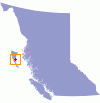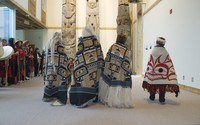The unofficial BC Travel & Tourism Guide
There are few places one can go in Canada or even the world where natural beauty and cultural interest are as seamlessly joined as on Haida Gwaii.
Even the name Haida Gwaii has stories old and new. Until a few years ago the name of the islands was officially the one given by western settlers in the 19th century, the Queen Charlotte Islands. The official name now is testament to a reconciliation of long standing differences between the government and the indigenous peoples.
But whatever the name of the land, these isolated islands are situated in one of the richest marine environments in the world. Only 47 km south of Alaska, they are much more temperate in climate than would be expected for their northern latitude. The ocean in this area is rich in nutrients and supports a diverse and complex food chain, from plankton and herring upwards to salmon and whales. Heavy winter rains support some the greatest temperate forests in the world.
The ‘island’ is in fact an archipelago, 120 km off the mainland coast. The cluster of over a hundred islands is divided by a dizzying array of channels and inlets. There are two major bodies of land: to the north, Graham Island holds most of the population of 5000 permanent residents, with a centre in Masset. To the south, Central Moresby has the ferry landing at Skidegate. South Moresby holds Gwaii Haanas National Park Reserve & Haida Heritage Site. Here land and sea are preserved and the last vestiges of authentic, ancient Haida villages can be visited. Over 500 archeological sites have been recognized.
Much of the transportation from one part of the islands to another is either by boat or float plane; road works are limited by population, topography and weather.
It is little wonder that ecotourism is on the ascendant in such a place. Hiking trails are dispersed over much the northern island. Cyclists can use the main road from Queen Charlotte to Port Clemens, while logging roads provide terrain for mountain biking. There are numerous hiking trails through forests or on countless wild beaches. With such vast distances between populations, one of the great attractions of Haida Gwaii is the opportunity to be immersed in a great wilderness. Kayakers have long recognized the potential of these islands – but be warned, the ocean can be extremely wild, with winter waves of up to 35 meters pounding high cliffs on the west coast, and the inside passage nearly as rough. However, for the well-prepared boater, the archipelago offers endless opportunities to explore.
Fishermen are drawn to Haida Gwaii from all parts of the world, most in search of the king of sport fish, salmon. Whale watching and eco-tours are popular and surfing is taking hold, with numerous un-crowded breaks waiting for those willing to make the journey.
Whether you come for the nature or the history, Haida Gwaii will make for an unforgettable west coast experience in a unique part of the world.
Even the name Haida Gwaii has stories old and new. Until a few years ago the name of the islands was officially the one given by western settlers in the 19th century, the Queen Charlotte Islands. The official name now is testament to a reconciliation of long standing differences between the government and the indigenous peoples.
But whatever the name of the land, these isolated islands are situated in one of the richest marine environments in the world. Only 47 km south of Alaska, they are much more temperate in climate than would be expected for their northern latitude. The ocean in this area is rich in nutrients and supports a diverse and complex food chain, from plankton and herring upwards to salmon and whales. Heavy winter rains support some the greatest temperate forests in the world.
The ‘island’ is in fact an archipelago, 120 km off the mainland coast. The cluster of over a hundred islands is divided by a dizzying array of channels and inlets. There are two major bodies of land: to the north, Graham Island holds most of the population of 5000 permanent residents, with a centre in Masset. To the south, Central Moresby has the ferry landing at Skidegate. South Moresby holds Gwaii Haanas National Park Reserve & Haida Heritage Site. Here land and sea are preserved and the last vestiges of authentic, ancient Haida villages can be visited. Over 500 archeological sites have been recognized.
Much of the transportation from one part of the islands to another is either by boat or float plane; road works are limited by population, topography and weather.
It is little wonder that ecotourism is on the ascendant in such a place. Hiking trails are dispersed over much the northern island. Cyclists can use the main road from Queen Charlotte to Port Clemens, while logging roads provide terrain for mountain biking. There are numerous hiking trails through forests or on countless wild beaches. With such vast distances between populations, one of the great attractions of Haida Gwaii is the opportunity to be immersed in a great wilderness. Kayakers have long recognized the potential of these islands – but be warned, the ocean can be extremely wild, with winter waves of up to 35 meters pounding high cliffs on the west coast, and the inside passage nearly as rough. However, for the well-prepared boater, the archipelago offers endless opportunities to explore.
Fishermen are drawn to Haida Gwaii from all parts of the world, most in search of the king of sport fish, salmon. Whale watching and eco-tours are popular and surfing is taking hold, with numerous un-crowded breaks waiting for those willing to make the journey.
Whether you come for the nature or the history, Haida Gwaii will make for an unforgettable west coast experience in a unique part of the world.
Haida Gwaii Accommodations
Haida Gwaii Things to Do
British Columbia



Ph. n/a or 250-559-7885
(Artists & Fine Art Artisans, Aboriginal arts/ First Nation, Jewellery, Traditional boat building | First Nations | Galleries/ Exhibits/Shows | Museum | Performing Arts | Workshops/Classes)